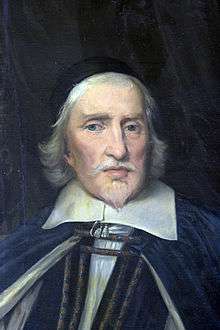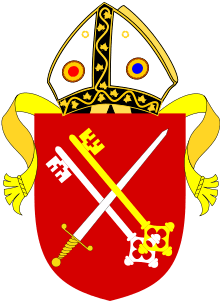Brian Duppa
| The Right Reverend Brian Duppa | |
|---|---|
| Bishop of Winchester | |
 A contemporary portrait of Bishop Duppa | |
| Church | Church of England |
| Diocese | Diocese of Winchester |
| In office | 28 August 1660 (translation)–1662 (death) |
| Predecessor | Vacancy (English Interregnum) |
| Successor | George Morley |
| Other posts |
Lord Almoner (7 July 1660[1]–1662) & Prelate of the Garter (1660–1662)[2] Bishop of Salisbury (December 1641[1]–1660) Bishop of Chichester (13 June 1638 {confirmed}[3]–1641) Vice-Chancellor of the University of Oxford (1632–1634) Dean of Christ Church (1628–1638) |
| Personal details | |
| Born |
10 March 1589 Lewisham, Kent, England[4] |
| Died |
26 March 1662 (aged 73) Richmond, Surrey, England |
| Buried | 24 April 1662, Westminster Abbey |
| Nationality | English |
| Denomination | Anglican |
| Parents | Jeffrey Duppa[1] |
| Spouse |
1. An aunt of William Salter[5] 2. Jane Killingtree, 23 November 1626 (married)[1]–? |
| Profession | tutor |
| Education | Westminster School |
| Alma mater | Christ Church, Oxford |
Ordination history of Brian Duppa | |||||||||||||||||||||
|---|---|---|---|---|---|---|---|---|---|---|---|---|---|---|---|---|---|---|---|---|---|
| |||||||||||||||||||||
| |||||||||||||||||||||
| Source(s): [1][6][7][8] | |||||||||||||||||||||
Brian Duppa (also spelled Bryan; 10 March 1589 – 26 March 1662)[1] was an English bishop, chaplain to the royal family, Royalist and adviser to Charles I of England.[9]
Life
He was educated at Westminster School and Christ Church, Oxford, graduating BA in 1609.[10] He was a Fellow of All Souls College, Oxford in 1612.[11] According to the list of Vicars in Westham Church he was vicar at this Sussex parish from 1625 and Vice-Chancellor of the University of Oxford in 1632. He became chaplain to Edward Sackville, 4th Earl of Dorset, who as his patron helped him become Dean of Christ Church.
He was chaplain to Charles I from 1634, and tutor to his two sons.[12] He was regarded as a follower of William Laud.[13][14] He was involved in the approval by Charles I of the manuscript of Eikon Basilike, reading it to the King in Carisbrooke Castle.[15]
Duppa was made Bishop of Chichester (1638). From two years later (marking the start of the Civil War) until death he lived much more quietly at Richmond,[16] (as Bishop of Salisbury from 1641), one of the few Anglican bishops to remain in office during the English Interregnum.[17]
In 1660, on the return from exile of Charles II of England to restore the monarchy, Duppa was made Bishop of Winchester, and Lord Almoner. He died two years later.[11]
Works
He was editor of Jonsonus Virbius (1638), a collection of memorial verses from various authors for Ben Jonson.[18]
Eponymous places
A hill and a park bear his name given mostly to sports fields: Bishop Duppas Park in Lower Halliford, Shepperton, Surrey[19] and seemingly Duppas Hill in Waddon, Croydon, London reflecting his influence on the previously ecclesiastical property.
Two sets of Bishop Duppa's almshouses were erected with his funds or endowed with his lands, one with original components, and one a 19th-century successor development:
- Duppa's Almshouses, Pembridge, Herefordshire[20]
- Bishop Duppa's Almshouses, Richmond,[21] now owned by Richmond Charities.
In literature
Bishop Duppa appears in Robert Neil's historical novel "Crown and Mitre", set in 1659. In the last days of the Commonwealth the Bishop, living at a modest house in Richmond, is shown having a clandestine meeting with the emissaries of the exile King Charles II, to discuss plans for the Restoration.
Notes
- 1 2 3 4 5 6 "Duppa, Brian". Oxford Dictionary of National Biography (online ed.). Oxford University Press. doi:10.1093/ref:odnb/8303. (Subscription or UK public library membership required.)
- ↑ Thoyras, Rapin de & Tindal, N. The History of England, continued from the Revolution to the Accession of King George II. Vol. IV. Part II. p. 236 Accessed 14 September 2014
- ↑ Appointment Record: Duppa, Brianus (at Chichester) in "CCEd, the Clergy of the Church of England database" (Accessed online, 14 September 2014)
- ↑ Edward Hasted (1797). "Parishes: Lewisham". The History and Topographical Survey of the County of Kent: Volume 1. Institute of Historical Research. Retrieved 22 September 2013.
- ↑ Bannerman, W. Bruce (ed.) Miscellanea Genealogica et Heraldica. Vol. II p. 42 Accessed 14 September 2014
- ↑ Ordination Record: Duppa, Brianus in "CCEd, the Clergy of the Church of England database" (Accessed online, 14 September 2014)
- ↑ Appointment Record: Duppa, Brianus (at Chichester) in "CCEd, the Clergy of the Church of England database" (Accessed online, 14 September 2014)
- ↑
- ↑ Charles I, by W.H. Hutton (1912) – Anglican History Society
- ↑ Margaret Griffin, Regulating Religion and Morality in the King's Armies, 1639–1646 (2004), p. 188.
- 1 2 Concise Dictionary of National Biography
- ↑ March 10 (born) and featured individual: Good Bishop Duppa Chambers Book of Days, 1869, Robert Chambers, Edinburgh and London
- ↑ Michael C. Questier (editor), Catholicism and Community in Early Modern England: Politics, Aristocratic Patronage and Religion, c. 1550–1640 (2006), p. 494.
- ↑ British Civil Wars Charles, Prince of Wales, (later Charles II), 1630–85
- ↑ Jim Daems, Holly Faith, Eikon Basilike: The Portraiture of His Sacred Majesty in His Solitudes and Sufferings (2006), p. 20.
- ↑ The Environs of London: volume 1: County of Surrey: Richmond Daniel Lysons, Institute of Historical Research, 1792. Retrieved 22 September 2013
- ↑ Robert David Redmile, The Apostolic Succession and the Catholic Episcopate in the Christian Episcopal Church of Canada (2006), p. 183.
- ↑ The Cambridge History of English and American Literature: An Encyclopedia in 18 Volumes. Vol. 6. "The Drama to 1642, Part Two". 1907–21 I. Ben Jonson. §5. Later years.
- ↑ Susan Reynolds (Editor) (1962). "Shepperton: The hundred of Spelthorne (continued)". A History of the County of Middlesex: Volume 3 at Shepperton. Institute of Historical Research. Retrieved 6 June 2013.
- ↑ Duppa's Almshouses, Pembridge Historic England. "Details from listed building database (1081719)". National Heritage List for England. Retrieved 22 September 2013.
- ↑ Bishop Duppa's Almshouses, Richmond Historic England. "Details from listed building database (1253024)". National Heritage List for England. Retrieved 22 September 2013.
References
- Gyles Isham, Justinian Isham (editors), The Correspondence of Bishop Brian Duppa and Sir Justinian Isham, 1650–1660, Publications of the Northamptonshire Record Society Volume XVII
External links
- Project Canterbury page
- "Duppa, Brian (DP641B)". A Cambridge Alumni Database. University of Cambridge.
| Academic offices | ||
|---|---|---|
| Preceded by Richard Corbet |
Dean of Christ Church, Oxford 1628–1638 |
Succeeded by Samuel Fell |
| Preceded by William Smyth |
Vice-Chancellor of Oxford University 1632–1634 |
Succeeded by Robert Pink |
| Church of England titles | ||
| Preceded by Richard Montagu |
Bishop of Chichester 1638–1641 |
Succeeded by Henry King |
| Preceded by John Davenant |
Bishop of Salisbury 1641–1660 |
Succeeded by Humphrey Henchman |
| Vacant Title last held by Walter Curle |
Bishop of Winchester 1660–1662 |
Succeeded by George Morley |
